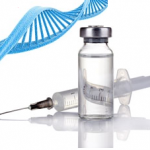CRISPR Has the Potential to Snip Out Sickle Cell Disease
Sickle cell disease affects about 100,000 people in the United States, according to the Centers for Disease Control and Prevention (CDC), and affects millions of people across the globe. A new technology, known as CRISPR, may change all that.
CRISPR is short for “clustered regularly interspaced short palindromic repeats.” It is a group of technologies capable of editing the genes in people with inherited conditions, such as sickle cell disease.

Sickle cell disease is an inherited disorder that affects red blood cells, which transport oxygen to the rest of the body. Specifically, sickle cell disorders affect hemoglobin (Hgb), which is the protein in red blood cells responsible for transporting oxygen. A mutation in a single DNA letter (S) causes the sickle cell trait to be passed from one generation to the next. People with sickle cell disorders inherit an abnormal version of hemoglobin, known as Hgb S, which distorts the shape of the red blood cells.
Red blood cells normally have a round donut shape that allows them to carry an ample supply of oxygen, and to flow through tiny blood vessels smoothly. People with sickle cell inherit a trait that, during a sickle cell crisis, causes the normally round blood cells to resemble the C-shaped farm tool known as a sickle. The sickle cells become hard and sticky, so they clump together instead of flowing freely.
The cells are fragile and prone to rupturing, which can lead to anemia. The deformed cells also die early, which causes a constant shortage of red blood cells. The abnormal shape also means the cells can block blood vessels and damage tissue. This can cause pain, infections, a lung problem known as acute chest syndrome, stroke and other serious health issues during a sickle cell crisis and afterwards.
Current treatments involve blood transfusions, the drug hydroxyurea and bone marrow transplants. Each of these comes with risks and complications.
Enter CRISPR
CRISPR is a group of gene editing technologies that allow scientists to change an organisms DNA by adding, removing or altering specific locations within the gene. Researchers created CRISPR by adapting a naturally occurring gene editing system in bacteria, which captures little snippets of an invading virus’s genes. If the virus ever attacks again, the bacteria use the snippets to create and insert a new DNA sequence into the virus, which effectively changes the virus.

The technology works the same in the lab, except to produce positive results. Scientists first remove the snippet of the “bad” gene that causes sickle cell, using CRISPR to cut the sickle cell gene (S) from a precise location in DNA, and replaces it with healthy genes. Scientists then attach healthy hemoglobin genes to a harmless virus, and then put the virus and the corrected genes it carries back in the patient’s body.
Researchers from the National Institutes of Health performed a clinical trial in which they used CRISPR to edit the genes of nine people with sickle cell disease. The lead researcher, John Tisdale, spoke about their progress and said that all of the people who had received the gene therapy had good hemoglobin levels and that none of the participants had experienced sickle cell crises.
More research is necessary before gene editing becomes a common course of treatment, but CRISPR may someday help all people overcome sickle cell disease and its complications.
Frank Magliochetti owes his professional success to his expertise in two areas: medicine and finance. After obtaining a BS in pharmacy from Northeastern University, he stayed on to enroll in the Masters of Toxicology program. He later specialized in corporate finance, receiving an MBA from The Sawyer School of Business at Suffolk University. His educational background includes completion of the Advanced Management Program at Harvard Business School and the General Management Program at Stanford Business School. Frank Magliochetti has held senior positions at Baxter International, Kontron Instruments, Haemonetics Corporation, and Sandoz. Since 2000, he has been a managing partner at Parcae Capital, where he focuses on financial restructuring and interim management services for companies in the healthcare, media, and alternative energy industries. Earlier this year, he was appointed chairman of the board at Grace Health Technology, a company providing an enterprise solution for the laboratory environment.
Mr. Frank Magliochetti MBA
Managing Partner
Parcae Capital
www.parcaecapitalcorp.com
www.frankmagliochetti.com







